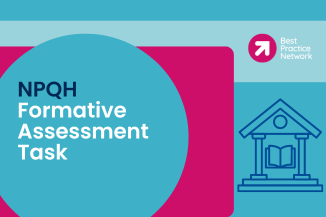
Designing a Culture to Optimise Student Behaviour
NPQH Participant, Spring 2022
In defining norms and routines, Bennett’s work on culture was, and continues to be, key. Now, the recognition that whole school level behaviour is paramount (4.LT.1), leads us to examine how we have created and maintained a clear school behaviour policy across the whole school. We used data, views and observations to examine culture including during extra-curricular activities and in communal spaces. They were seen widely. Teaching our model behaviours using consistent language (4.LHT.g) early interventions are effective. Yet, whole school change takes longer and our exemplary ‘encouraged’ behaviours are demonstrated at times but not as widely (4.LHT.c). Student behaviour in lessons is usually exemplary covering both permitted and desired behaviours. Yet out of lessons, desired behaviours are not seen as often.
Positive reinforcement for desired behaviours, especially in relation to aspirations and long-term goals (4.LT.10) are currently seen less and there is a blurring of permitted and desired. For desired behaviours to occur more frequently, we need to model and explicitly describe them. Consequently, staff training will now be built into the development calendar (4.LHT.g).
Social norms are explicit and reviewed regularly (4.LHT.d). Almost all students see themselves as a valued member of the school community. After Covid, students who found it more challenging to see themselves as part of a hard working and respectful community increased. The school supports them with reasonable adjustments. We will now provide further staff training to ensure all staff consider it is in their power to help shape these individuals (4.LHT.m). When SLT are visible, and there is a dedicated pastoral team, there may be a temptation to feel that others are better at dealing with these students and therefore they do not.
Behaviour is a whole school focus in whole school and SLT planning. Tracking and analysis takes place regularly. Behaviour is on meeting agendas, but is often in response to a request for feedback. We need to increase the visibility of behaviour and praise, putting it at the forefront of meeting agendas, also tying it to encouraged behaviours, values and attitudes we wish to see (4.LHT.d). This will be a standing item, ensuring staff continue to see behaviour can be shaped in order to support encouraged behaviour.
We communicate desired culture quite effectively beyond school. School awards and rewards systems make explicit, behaviours which are valued. The parent newsletter has articles linked explicitly to the school values and culture. Student and staff induction are explicit in school values and culture. At times, the communication could go even further by explaining values which sit behind expected and desired behaviours. For example, if students haven’t yet joined a club, we can explain how clubs support character development. We should explicitly link short term actions to long term goals and future life (4.LHT.i).
SLT support school vision and in our behaviour policy permitted, prohibited and desired behaviours are made explicit (4.LHT.a). Culture and behaviour are discussed frequently. It is part of the appointment and induction process for staff. In reality, the team can find it difficult to balance their own day to day responsibilities and competing priorities. SLT is very visible in supporting all aspects of behaviour although we do not all discuss the methods that we support and embed the school values and how we encourage behaviour. This now needs to be explicit in our meetings, revisited at regular intervals to ensure we have a shared understanding and we share actions we can take to foster culture. The more explicit we are within SLT, the more explicit we will be within all subsequent communication within school and with stakeholders such as parents, carers and the community.
Notes:
Learn that (LT)
4.LT.1 - While classroom-level strategies have a big impact on pupil behaviour, consistency and coherence at a whole school level are paramount.
4.LT.10 - A predictable and secure environment benefits all pupils, but is particularly valuable for pupils with special educational needs
Learn how to (LHT)
4.LHT.a - Creating, implementing, and consistently applying a clear school behaviour policy across the school.
4.LHT.c - Ensuring that a positive, predictable and safe environment is maintained consistently across the school, including during extra-curricular activities, communal spaces, on school trips and travelling to and from school.
4.LHT.d - Encouraging teachers to model specific behaviours (including self-regulation) for pupils.
4.LHT.g - Developing colleagues’ ability to respond consistently to pupil behaviour through thoughtful application of recognition, rules and sanctions in line with the school’s approach; giving manageable, specific and sequential instructions; using consistent language and non-verbal signals for common classroom directions; using early and least-intrusive interventions as an initial response to low level disruption and responding quickly to any behaviour or bullying that threatens emotional safety.
4.LHT. i - Ensuring it is clear to colleagues how the curriculum and extra-curricular activities can be related to pupil aspirations and long-term goals, alongside being able to express the inherent value of mastering content.
4.LHT.m - Encouraging colleagues to select, adapt and consistently use targeted, age/developmentally appropriate interventions without lowering expectations of any pupil’s behaviour (e.g. functional behavioural assessment interventions and daily report cards).
Want to know more?
If you would like to know more about NPQs and how they can benefit your teaching career, explore the NPQs we offer or get in touch with one of our friendly advisors using the details below:
Email: npq@bestpracticenet.co.uk
Tel: +44 (0) 117 920 9200 (8.30am-5.30pm, Mon-Fri)

